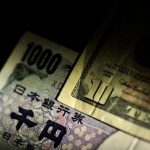(Reuters) -The dollar steadied on Wednesday as soft U.S. economic figures weighed by boosting U.S. rate-cut bets but political jitters in Europe offered some support by weakening the euro.
Meanwhile sterling rose after data showed UK service inflation was stronger than expected.
U.S. retail sales barely rose in May and previous month’s figures were revised down, data showed on Tuesday, suggesting that economic activity remained lacklustre in the second quarter.
That pushed the U.S. currency lower, though it later regained some ground against a basket of currencies as the euro, which holds the largest weight in the dollar index, remains under pressure from political turmoil in France and the wider bloc.
The euro was last marginally lower at $1.0732, while the dollar index was flat at 105.27.
The yield gap between French and German government debt, which is now seen as a gauge of risks of a budget crisis at the heart of Europe, eased slightly since Monday but remained close to its seven-year highs hit last week. “We thought that the U.S. retail sales would be weak, and it was,” said Joseph Capurso, head of international and sustainable economics at Commonwealth Bank of Australia (OTC:CMWAY).
“Things are finally deteriorating. It looked like the U.S. consumer was never going to slow down, but looks like that’s exactly what happened now.”
Markets are now pricing in a 67% chance the Fed will begin easing rates in September, according to the CME FedWatch tool, with nearly 50 basis points worth of cuts expected this year.
Sterling rose 0.20% against the euro to 84.34 pence per euro and 0.15% against the dollar to $1.2725 after data.
British inflation returned to its 2% target in May for the first time in nearly three years, data showed on Wednesday, but underlying price pressures remained strong.
“This (service inflation figure), we think, will raise the bar for an August rate cut,” said Sanjay Raja, chief UK economist at Deutsche Bank Research.
“What matters now is how much stock the Monetary Policy Committee puts on the spot – and arguably backward-looking – data,” he said, noting that survey figures have been “more encouraging.”
Markets priced an around 30% chance of a Bank of England rate cut in August, down from 50% before data, and 44 basis points of monetary easing in 2024, down from almost half percentage point before figures.
The BoE holds its policy meeting on Thursday.
The Swiss Franc hit a fresh seven-month high against the euro at 0.9475, up 0.14%.
The euro has weakened constantly against the Swiss currency since the end of May when it hit 0.9930 per franc, its highest since April 2023.
“Some observers see this as a renewed threat of intervention or as an implicit put that (Swiss National Bank Chairman Thomas) Jordan is offering to all market participants who hold long CHF positions, especially against the euro,” said Ulrich Leuchtmann head of forex strategy at Commerzbank (ETR:CBKG), recalling a speech by Jordan at the end of May.
Jordan argued that inflation risks would likely be associated with a weaker Swiss franc, which the SNB “could counteract by selling foreign exchange.”
The Australian dollar was a notable outperformer against the U.S. currency, also helped by a hawkish message from Reserve Bank of Australia Governor Michele Bullock after the central bank’s rate decision on Tuesday.
The Aussie was last 0.12% higher at $0.6664, extending its 0.66% gain from the previous session. Meanwhile, the New Zealand dollar fell 0.19% to $0.6133.
Elsewhere, the yen was little changed at 157.83 per dollar, as it continues to be pressured by stark interest rate differentials between Japan and the U.S., in particular.

Bank of Japan Governor Kazuo Ueda said on Tuesday the central bank could raise interest rates next month depending on economic data available at the time.
Analysts said further policy normalisation was on the horizon, but they expected the BOJ to take a slow approach.
To read the full article, Click Here

